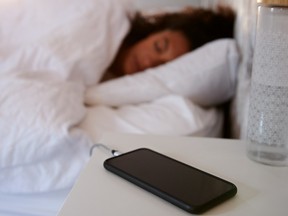Here’s what to know about the risk and how to get the most out of a charge and make your cellphone battery last longer

“Low Battery: 10 per cent of battery remaining.”
You immediately switch to lower power mode in hopes of stretching out another 10 minutes of blue screen-induced happiness, but reality soon sets in: you need to plug in.
So you do, begrudgingly.
It’s advice firefighters in Montreal were issuing following a port fire this week “fuelled by 15,000 kilograms of lithium-ion batteries” inside a shipping container. The noxious smoke from the fire led to a lockdown in one borough and air quality warnings for other downwind residents.
When should I charge my cellphone?
“That way, if something happens, you’re alert and can detect it quickly.”
But recognizing that 98 per cent of people are going to maintain their twilight charging habits regardless of the prevailing wisdom from fire and battery experts, MacNeil’s guidance is to at least consider where and how it’s charging overnight.
“Don’t charge it underneath a pillow or something like that,” MacNeil told the National Post. “Choose a location that’s a little bit further away from you personally, but not blocking the exit, and (make sure) it has good ventilation.
“For kids, probably the safest way to do it is just to make sure they don’t have any chargers in the rooms.”
How big is the risk of charging your phone overnight?
Ultimately, and without discounting the outcome of incidences that have had destructive or tragic outcomes, the risk of your phone, tablet or laptop experiencing thermal runaway — the process where the battery cell is overheated to the point it can catch fire or explode — is very low.
“There’s been a lot of advances in technologies and it’s fairly rare to see these events in phones, as long as they’re not abused,” MacNeil explained from Ottawa. “It’s a much rarer event than 10 years ago.”
He said just about every personal electronic device has a cooling mechanism built in to address the heat picked up during charging and most modern phones have battery management systems that moderate the flow of electrons from the power grid.
Charging it on a bed or couch, in direct sunlight, or for longer than recommended are also factors that can potentially lead to overheating.
As for your protective phone case or the reinforced one keeping your kid’s gaming pad from breaking after being dropped 20 times a day, MacNeil suggested “a good case would affect how it cools” and it’s probably worth removing during the charge.
“But again, it comes back to that convenience factor. I don’t know many people that would be removing their case each time that they want to charge.”
Is my battery damaged?
You might be thinking your phone or tablet is fine, right? And it might be. But how many times has it been shaken or tossed about, survived a drop or been plugged into poor quality or faulty charger?
Chief among the symptoms to look for is swelling in the device. “That’s a very telltale sign that something’s off,” MacNeil remarked.
Discolouration, leaking, an odour and odd noises are other warning signs, and if the device heats up significantly while charging, it’s probably toast.
“Say you pull it off of the charger and you notice that the phone is really hot — that’s an indication that you shouldn’t really be charging that again.”
A damaged cord, while not connected to thermal runaway, should be tossed, too, MacNeil added.
On the subject of third-party cords — because who really wants to keep paying $25+ every six months? — MacNeil said do your best to ensure it’s been tested for safety.
“As much as possible, try to get the (original equipment manufacturer) part, but if you’re going the other way just make sure it’s a certified one.”
Battery tip
Wanna get the most of out a charge, make your phone’s battery last longer and reduce the risk of thermal runaway? Switch to its lower power mode while charging.
“It allows your battery to extend life because it doesn’t go through what are called parasitic side reactions that occur in batteries, or just side reactions that happen inside the cell, and those usually happen at really high states of charge,” explained MacNeil.
“If someone is worried about thermal events, which are very rare, that is the most effective way to extend the life of the battery, but lower its reactivity.”
MacNeil’s final piece of advice is simpler than the science of battery cells: make sure you’ve got smoke detectors.
“I sound like a fire chief or something, but it really is probably the most effective way to ensure (safety). Wherever you’re charging, make sure you’ve got a smoke detector that’s in working order nearby.”
Our website is the place for the latest breaking news, exclusive scoops, longreads and provocative commentary. Please bookmark nationalpost.com and sign up for our newsletters here.